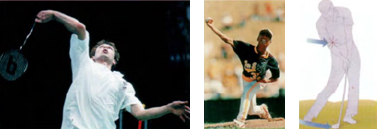Tennis elbow and golfer’s elbow are a result of vigorous use and movements or overstraining of the forearm muscles that move your fingers, hand, wrist and forearm. Overuse of your muscles really depends on how long you do something and how much effort you exert doing it.
The constant tugging at the point of attachment on the outside of your elbow (lateral epicondyle) or the inside of your elbow (medial epicondyle) can cause these tendons to become inflamed and strained. Your muscles and tendons can then become irritated which can result in weaker tendons, tiny tendon tears and development of scar tissue and/or calcium deposits. The development of scar tissue will put pressure on your soft tissue and nerves, and interrupt the blood flow to this area; this can be very painful.
Causes of Lateral Epicondylitis (Tennis Elbow)
Although over 50% of tennis players will experience tennis elbow at some point in time, it is caused by many common activities. It generally affects men and women between 35-65 years of age who stress their wrist and elbow through twisting or extending motions in repetitive work or activities. This condition is very common with sports participants (racquet sports, golfers, fencers, swimmers, throwing sports) as well as plumbers, carpenters, landscapers, painters, waitresses, librarians, office workers and musicians.
Causes of Medial Epicondylitis (Golfer’s Elbow)
Golfer’s elbow is most common in men between 20 – 49 years of age, however it can affect anyone who uses their hands, wrists and fingers to wrap around instruments, type on keyboards, or grip objects (golfers, pitchers, racquet players, small parts manufacturers, office workers, lab technicians, hygienists, carpenters, wood choppers). It is most often a result of forceful contractions and overuse.
These injuries often have some mutual causes and can even be stimulated by normal activities such as pulling weeds, knitting or carrying a suitcase (especially when you don’t allow a previously injured elbow to heal properly or in enough time).
Occasionally, a direct hit to the outside of the elbow or falling onto an outstretched arm will cause these conditions, however it is very rare.
How to Treat Your Elbow Tendon Injury
It is important to treat tendon injuries as soon as possible, as any activity or strain you put on your tendon can re-injure it further.
The trick with any tendon injury is getting it toheal with minimal scar tissue formation. Even with optimum healing, there is always less elasticity in a previously injured tendon. This will cause the tendon to hurt, during exercise and everyday activities. However, if you heal your injury efficiently and quickly, your chance of re-injury later on is much lower than average.
Allowing your elbow to rest is always recommended following injury. Avoid all activities that may have caused the injury or irritation and begin cold compression treatments as soon as possible. Blood Flow Stimulation Therapy™ (BFST®) promotes blood flow to heal your tendon faster and more completely than any other methods available.
Although steroid injections may provide temporary relief from the pain of tendinitis or tendinosis, they should generally be avoided as they weaken the tendon. If you do opt for an injection, doctors usually recommend that you do not participate in strenuous activities for several weeks to reduce the risk of a rupture.
